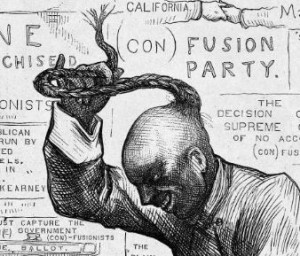From Matthew’s Gospel:
Jesus told a parable: “Listen to another parable. There was a landowner who planted a vineyard, put a fence around it, dug a wine press in it, and built a watchtower. Then he leased it to tenants and went to another country. When the harvest time had come, he sent his slaves to the tenants to collect his produce. But the tenants seized his slaves and beat one, killed another, and stoned another. Again he sent other slaves, more than the first; and they treated them in the same way. Finally he sent his son to them, saying, ‘They will respect my son.’ But when the tenants saw the son, they said to themselves, ‘This is the heir; come, let us kill him and get his inheritance.’ So they seized him, threw him out of the vineyard, and killed him. Now when the owner of the vineyard comes, what will he do to those tenants?” They said to him, “He will put those wretches to a miserable death, and lease the vineyard to other tenants who will give him the produce at the harvest time.”
(From the Daily Office Lectionary – Matthew 21:33-41 (NRSV) – July 2, 2014)
Today we went to many places where Jesus taught, many places where he told parables. We drove all around and all over God’s vineyard – or so it seemed.
Today’s breakfast at the Sisters of Nazareth Guest House was rather different from our breakfasts on other days at St. George’s. This was more European: a soft sesame sprinkled baguette, salami, cheese, a variety of fruit spreads (and some chocolate spread), orange juice, hard-boiled eggs. When we checked in last night, I said to Evelyn, “This is a French order. We’ll have real coffee!” I was wrong. The ubiquitous packets of instant coffee (Nescafe seems most popular in this country) were on the table. The cheese was surprising, too: what I would call “American processed cheese food” in individually plastic-wrapped slices, not real cheese. Nonetheless, a filling breakfast.
After breakfast, we headed to the River Jordan, just up from where it enters the Sea of Galilee. This is not where tradition says Jesus was baptized by John, but is a more secluded spot where Iyad likes to bring pilgrims. Keith Owen presided as we renewed our baptismal vows, asperging the group with an olive branch dipped in the river, then Mary Carson and I anointed any who wished to receive it. I somehow got so caught up in everything that I forgot to take any photographs! I’ll rely on others to supply those.
Several of us waded into the river (it has a soft sandy bottom, not muddy thank heaven) and I can personally attest that the River Jordan is NOT chilly and cold despite what the song says. We filled several bottles with river water to be used in baptisms back home.
Back on the bus (with wet sandy feet) and off we went to the Sea of Galilee proper where our first stop was the traditionally identified Mount of the Beatitudes where there is a Barluzzi church – one of his earliest and not as impressive as the others we’ve seen. Lovely gardens filled with citrus trees as well as many kinds of flowers. Lots of people from all over the world. After our visit there, we drove a short distance to the top of another hill (one someone is using as a repository for old tractors) and got off the bus. Iyad told us we were going to take a walk down the hill to another site much more likely to have been the site of the Sermon on the Mount. This site, Mark tells us, was identified by a Benedictine monk named Bargil Pixner who set up a very rustic outdoor chapel.
We hiked down the hill seeing numerous orchards of a variety fruits all around us, although we were hiking through desert terrain; we stopped at Pixner’s chapel, where Liddy Hoster presided as we celebrated the Eucharist. (Several of us took pictures of her doing so — and I regretted not asking anyone to do so when I celebrated yesterday. O well…..) Then a short climb down to where the bus was waiting. Stopping short of the bus, Iyad explained to us how Jesus could have preached to 5,000 or more people in this place, and Mark — standing at the mouth of a cave in the hillside — demonstrated the acoustic properties of the cave, which amplified his reading of the Beatitudes so that we could hear it quite a ways a way, even with intervening motor traffic!
From there, we walked past the bus to Mensa Christi (Table of Christ), another Barluzzi church commemorating Jesus’ post-Resurrection breakfast of grilled fish with the disciples. This simple chapel is right on the beach of Lake Galilee. Several of us waded in and I collected three small stones to place in the font when we baptize back home. (I had planned to bring back stones from the Jordan River but the place where we renewed our baptismal vows was not stony, so I got them here.)
Then back on the bus! You kind of get the story of this pilgrimage so far — lots of stuff to do, many places to go and see, lots of riding on the bus. This time our ride ended at the Tanurin Restaurant where we enjoyed a lunch of (basically) fish and chips preceded by the usual assortment of salads: ginger marinated carrots, tabouleh, cabbage slaw (this time with sesame seeds added), a spicy tomato and onion relish, pickled corn kernel salad, hummus, cucumbers in a sour cream dressing, all served with lots of pita (including, this time, pita toasted with butter, basil, and garlic). Then the main course of fish with French fries. We had the option (which two of us took) of getting a whole roasted St. Peter’s fish – most opted for a simple filet.
After eating fish, we went for a boat ride! We went to the Man in the Galilee Museum where a First Century boat has been preserved and put on display, watched a video about the preservation of the boat, then went for a ride on an excursion boat. The wind kicked up while we were on the water, so we had some appreciation of the story of the storm that frightened the apostles (although our storm wasn’t really very scary).
Next we went to Capernaum, a short bus ride away, again past numerous fruit orchards. Here a very modern church built in the 1990s in the shape of an eight-sided flying saucer is literally suspended from black stone pillars over the excavated ruins of an octagonal Byzantine church believed to have been built on the traditional site of St. Peter’s home. A Roman era synogogue is nearby (like almost next door!) and has been partially restored. The “flying saucer” church has a glass floor through which the ruins of the Byzantine church can be seen!
Our final location of the day was at Tabgha (the name is an Arabic corruption of the original Greek name meaning “seven springs”) where a modern Benedictine monastery and church commemorates the feeding of the 5,000. In front of the altar is the mosaic of loaves and fishes which is famous to the area.
After that, it was back to the Guest House to take a quick shower before Iyad shared with us a “surprise.” The surprise was a trip into the caves under the Sisters’ convent where some ruins discovered in the middle of the 20th Century are believed to be the home in which Jesus was raised! There is also a cistern showing years and years of use and, further down, a burial tomb of exactly the sort that would have been used when Christ was crucified. The whole narrative of his removal from the cross, his placement in the tomb prepared by Joseph of Arimethea, and Mary Magdalene’s trip to the tomb on Sunday morning now makes so much more sense!
Then dinner (a sensible European meal of meat and potatoes), compline, and bed — but not before a walk through the market area of the town and a stop at the local sweets shop!
Mark Stanger, our priest guide (Iyad’s assistant on this tour), commented that a visit to a Middle Eastern sweets shop smells like a visit to Crabtree & Evelyn because they use so many floral flavorings (like rose and geranium). So it was! We went to one where the pastries are all laid out on large trays – you fill a plate and pay by weight. I had baklava (both the traditional and “bird’s nest” style), kanafeh (a goat cheese concoction), semolina-almond balls (a sort of donut hole that has been described as “deep fried honey”), qatayef (a small cinnamon-flavored pancake folded and stuffed with nuts and dried fruit), and freshly made halvah. The plate of sweets was at least 10,000 calories and a diabetic coma waiting to happen, but O, my! it was good! (Although, people keep assuring me that just like coffee hours at church, food consumed on pilgrimage has no caloric content.)
As we traveled throughout the day, one of the recurring images was of food and the production of fruit. There were vineyards to be sure, but also orange groves, mango orchards, banana plantations (yes! bananas!), olive orchards, and others; and then there were those meals! This can be a fruitful land and could be even more so if the tenants would stop fighting with one another, and cooperate with the landlord and with each other. Unfortunately, they seem little inclined to do so — God doesn’t need to put these “wretches to a miserable death;” they are doing that themselves. The news of the day, again, was filled with mentions of the kidnapping and killing of teenagers. We enjoyed a lovely day in a land filled with sadness. It’s all very confusing.
====================
A request to my readers: I’m trying to build the readership of this blog and I’d very much appreciate your help in doing so. If you find something here that is of value, please share it with others. If you are on Facebook, “like” the posts on your page so others can see them. If you are following me on Twitter, please “retweet” the notices of these meditations. If you have a blog of your own, please include mine in your links (a favor I will gladly reciprocate). Many thanks!
====================
Father Funston is the rector of St. Paul’s Episcopal Church, Medina, Ohio.
 Believe it or not, I’ve actually had the last of these selected verses quoted to me as part of an argument against the use of incense in the church. I was in a conversation with someone about our use of incense in “high church” liturgies, being told (among other things) that incense was fine when we were younger and acting like hippies but now that we are older and mature we should put aside such childish ways, when this chestnut was pulled out. Since I’ve studied the Old Testament (as most clergy have) I knew my critic was misusing the text.
Believe it or not, I’ve actually had the last of these selected verses quoted to me as part of an argument against the use of incense in the church. I was in a conversation with someone about our use of incense in “high church” liturgies, being told (among other things) that incense was fine when we were younger and acting like hippies but now that we are older and mature we should put aside such childish ways, when this chestnut was pulled out. Since I’ve studied the Old Testament (as most clergy have) I knew my critic was misusing the text. Great! Here it is, the single phrase in Paul’s writing, the single preposition the translation of which can radically change one’s understanding of the doctrine of justification by faith. But . . . I’m not going to address that doctrine this morning; I’m more interested right now in ambiguity.
Great! Here it is, the single phrase in Paul’s writing, the single preposition the translation of which can radically change one’s understanding of the doctrine of justification by faith. But . . . I’m not going to address that doctrine this morning; I’m more interested right now in ambiguity. If Jesus stands for anything, he stands for community, for the ability of people graced by God to reconcile with one another despite their differences. Yet even he acknowledges that there are times when reconciliation is impossible, that there are people who will not engage in constructive dialog, will not compromise, and will not modify their behavior. His advice is to let such a person go: “Let such a one be to you as a Gentile and a tax-collector.”
If Jesus stands for anything, he stands for community, for the ability of people graced by God to reconcile with one another despite their differences. Yet even he acknowledges that there are times when reconciliation is impossible, that there are people who will not engage in constructive dialog, will not compromise, and will not modify their behavior. His advice is to let such a person go: “Let such a one be to you as a Gentile and a tax-collector.” Until I undertook a little bit of Greek language study, I always thought Jesus’ pronouncements of woe were angry condemnations, predictions of doom, and certainly they can be that. On the other hand, they can be understood as something very different. The Greek word translated as “woe” is ouai which can also (and perhaps more properly) be translated as “alas.” The word is onomatopoeic, representing a deep sigh of sorrow or resignation. Perhaps Jesus is not so much condemning as mourning.
Until I undertook a little bit of Greek language study, I always thought Jesus’ pronouncements of woe were angry condemnations, predictions of doom, and certainly they can be that. On the other hand, they can be understood as something very different. The Greek word translated as “woe” is ouai which can also (and perhaps more properly) be translated as “alas.” The word is onomatopoeic, representing a deep sigh of sorrow or resignation. Perhaps Jesus is not so much condemning as mourning. “O great,” I think, reading this story. “Here’s one of those fairy tales that make the story of Jesus so unbelievable for some people.” Let’s face it, a fish with a silver coin in its mouth that’s just enough to pay the taxes levied by the authorities ranks right up there with Jack’s magic beans, the goose that laid golden eggs, and Rapunzel’s spinning wheel that made gold from straw. It has all the markings of the fantastic and none of the real.
“O great,” I think, reading this story. “Here’s one of those fairy tales that make the story of Jesus so unbelievable for some people.” Let’s face it, a fish with a silver coin in its mouth that’s just enough to pay the taxes levied by the authorities ranks right up there with Jack’s magic beans, the goose that laid golden eggs, and Rapunzel’s spinning wheel that made gold from straw. It has all the markings of the fantastic and none of the real.
 I have to admit that on first reading this, I had no idea what Qoheleth is saying here! Not the slightest.
I have to admit that on first reading this, I had no idea what Qoheleth is saying here! Not the slightest.  Jesus healed a paralytic. More than that, he told him that his sins were forgiven! The scribes became irate, accusing Jesus of blasphemy. Jesus asked them, “Which is easier to tell him his sins are forgiven or to tell him to get up and walk?” As a demonstration of power and authority, Jesus did both.
Jesus healed a paralytic. More than that, he told him that his sins were forgiven! The scribes became irate, accusing Jesus of blasphemy. Jesus asked them, “Which is easier to tell him his sins are forgiven or to tell him to get up and walk?” As a demonstration of power and authority, Jesus did both. 

